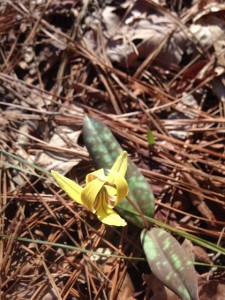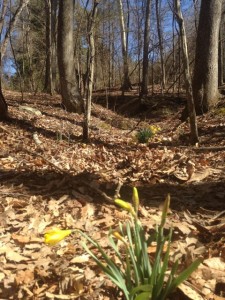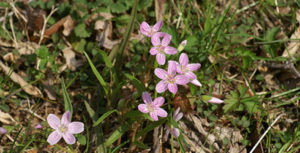

I’ll remember my three hikes over the weekend as such: long stretches of brown interrupted by flashes of the wrong kind of green, the less frequent wrong patches of white and one inspiring — but again, wrong — flash of yellow.
My objective on the trail this past weekend? Find signs of spring.
Ambitious, considering snow, ice and cold had dominated late winter until early last week. Then one 75 degree day, another in the 60s and — consarn it! — where’s spring? According to Carrboro naturalist Dave Cook and his “The Piedmont Almanac,” as early as the third week of February, “the first trout lilies and spring beauties might adventurously bloom” on slopes with southern exposures. By this, the second week of March, Cook writes, we should expect to see trout lilies in their “full glory.” Cook offers a caveat: your results may vary depending upon the weather.
Since second grade, I’ve avidly watched for the first signs of spring, though the cues have changed over the years. Beginning in early February I would rush home after school to rip open the sports section of The Denver Post, then an afternoon paper, and look for the first box score of spring training. Just seeing the early at-bats of Harmon Killebrew and Moose Skowran made me feel 10

degrees warmer — and realize that if it was warm enough to play baseball in Florida and Arizona, the grass would soon be greening in Colorado.
I still get a tingle hearing that pitchers and catchers have reported, but my new bellwethers for spring is rooted in nature: the first delicate yellow blooms of the trout lily, its petals resembling a preacher imploring his congregation to rise, the spring beauty, its cluster of tiny white and sometimes pink-tinged petals like Lilliputian satellite dishes.
Because of their numbers, the spring beauty is easier to spot. The trout lily is more reclusive, and because it stands just a half foot expends most of its height simply poking through winter’s leaf litter.
Several years back, near the end of a winter thaw, I tried to get Mike Dunn, naturalist extraordinaire now retired from the N.C. Museum of Natural Science, to head out to Umstead with me in search of trout lilies. I figured Mike would be in; every January he drops whatever he’s doing when the first warm rain of the year falls and acts as safety patrol for salamanders crossing the road in his Redbud neighborhood above the Haw River.
“It’s January,” he said. By his tone I knew not to pursue the matter.
So Saturday and Sunday, on the Mountains-to-Sea Trail along Falls Lake, along the Eno River between Pleasant Green and Pump Station, at Umstead State Park, I kept my eyes glued to the forest floor. I saw the blue flower of a thistle (I once posted a photo of such and received the ire of a purist who noted that, one, it was a weed, and two, it was not a native species). I spotted a lovely yellow bloom of daffodils (an ornamental I can’t take seriously thanks to Bullwinkle) just down the hill from a long-abandoned homestead, and I heard the encouraging, and the same time melancholy, call of the chorus frog.
Signs of spring, granted. But not the resounding crack-of-the-bat, spring-is-here assurance offered by the trout lily and spring beauty. Like a pitcher waiting on his catcher, I wait for spring to send me the right sign.
* * *
GetHiking! A Welcome to Spring
Interested in searching for signs of spring? Join us for A Welcome to Spring, a new GetHiking! program that starts March 25 and runs through May 20. Every Wednesday morning at 10 a.m., we will hike a different trail in the North Raleigh/Wake Forest area searching for signs of spring. To assist in this effort you’ll get a weekly enewsletter that, in addition to providing helpful hiking tips and resources, and a recap of the previous week’s hike, will include a preview of the upcoming hike focusing on the newest emerging sign of spring we’re likely to see.
Learn more about this fee program and sign up for GetHiking! A Welcome to Spring by visiting GetHiking! Triangle.
Like us on Facebook and get health, fitness and outdoors news throughout the day.
* * *
